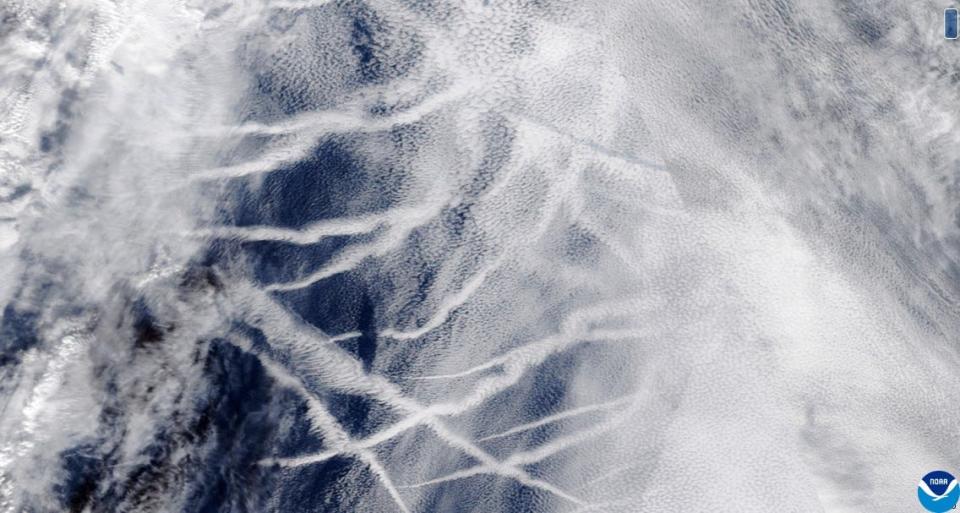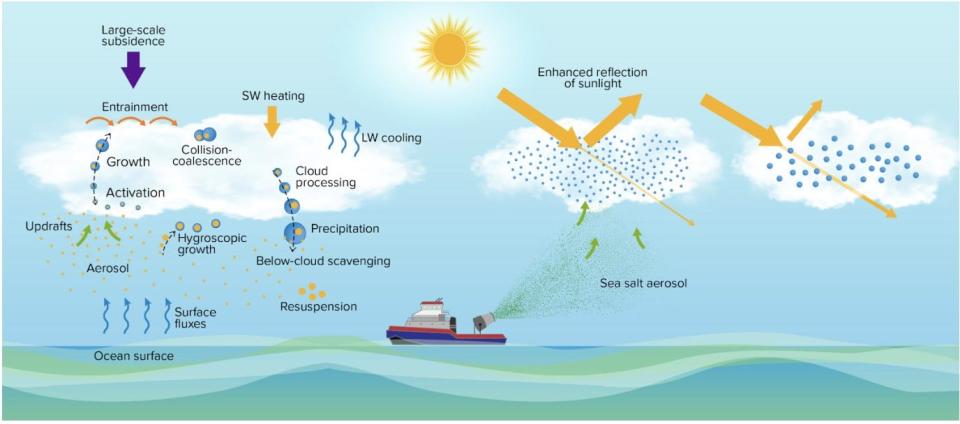Scientists ponder fighting climate change by making clouds brighter and thicker
Scientists keep studying creative ways to reduce global warming, and on Wednesday they highlighted another possibility: Making clouds over the oceans thicker and brighter.
This would involve a fleet of ships, which would crisscross vast stretches of the world's oceans, spraying seawater up into the clouds to thicken them, thus cooling the atmosphere underneath.
This geoengineering technique – widespread use of which is only in the theoretical stage at this point – is called "marine cloud brightening" (MCB), according to the National Oceanic and Atmospheric Administration. It's not new, either: The idea has been around for around 30 years.
What's new is a study published Wednesday in the journal Science Advances that lays out how viable this technique is and also proposes a program of research that includes laboratory studies, field experiments and cloud modeling.
“Interest in MCB is growing, but policymakers currently don’t have the information they need to reach decisions about if and when MCB should be deployed,” said study lead author Graham Feingold, a researcher with NOAA’s Chemical Sciences Laboratory, in a statement.
The goal of the new study "is to take stock of what we know and where the knowledge gaps are," Feingold told USA TODAY.
More: Some scientists have a new idea that could help fix climate change: Dry out the sky
How does marine cloud brightening work?
The goal of MCB is to make low-level clouds over the ocean more reflective and longer-lived by injecting them with small particles of salt generated by spraying seawater into the air.
Theoretically, according to NOAA, water vapor would collect on the surface of these salt particles, creating additional cloud droplets that would reflect more sunlight back out to space, cooling the globe.
The whole process is admittedly quite daunting: “We would have to get the right-sized particles into receptive clouds at the right times of day and seasons, and over large enough areas to shade large areas of ocean,” said Feingold. “It’s a major challenge.”

Is MCB a realistic solution for fighting climate change?
"It's too soon to say," Feingold said. "Challenges need to be overcome." He said that while it's possible to brighten clouds locally – the process exists and works – can it be scaled up to a global level?
Perhaps most importantly, artificially shading the planet would do nothing to reduce the primary driver of climate change, human-caused greenhouse gas emissions, said co-author Lynn Russell, a climate scientist at the Scripps Institution of Oceanography at the University of California, San Diego.
"The recent acceleration of impacts from global warming means that we need to consider non-ideal backup plans just to buy us enough time to reduce greenhouse gas emissions and existing burdens," Russell said. "A research plan is essential before we can consider adopting MCB, and we need to simultaneously address the physical science questions and the human dimensions."
“To reduce global temperatures, our highest priority should be to remove carbon dioxide from the atmosphere," Feingold said. "MCB might help to alleviate the worst impacts of climate change.”

What could go wrong?
Side effects of marine cloud brightening could include unknown and potentially hazardous changes to weather patterns. With MCB, "models show we're likely to get changes in atmospheric circulation. ... also changes in temperature and precipitation," Feingold told USA TODAY.
"With MCB, some will benefit, while others will suffer."
The study also didn’t address the social, ethical, ecological, or governance aspects of MCB.
In addition, although the study also didn't discuss the environmental impact of the ships, the general sense is "that the impact of these ships moving around the ocean would be insignificant, compared to current commercial shipping," Feingold said.
What do others say?
Kevin Trenberth, a scientist at the National Center for Atmospheric Research who was not involved in the study, told USA TODAY, "I believe that it is possible to brighten clouds but the consequences of that are far from clear."
"It is apt to change the patterns of weather," he warned.
Trenberth added that the article is correct in its understanding of how clouds change as the climate changes, and that they're not well simulated in climate models.
"But they do not address the problem of global warming. Even if the mechanism worked, it would not reduce carbon dioxide and the cause of global warming," he said.
This article originally appeared on USA TODAY: Climate change geoengineering study probes making clouds brighter
